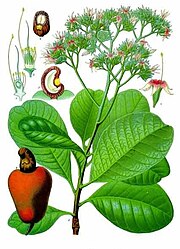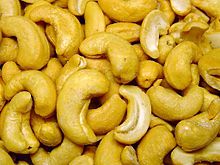Cashew: Difference between revisions
| Line 119: | Line 119: | ||
== Toxicology == |
== Toxicology == |
||
{{Expand-section|date=6 April 2010}} |
|||
== Compendial status == |
|||
{{Expand-section|date=6 April 2010}} |
{{Expand-section|date=6 April 2010}} |
||
Revision as of 06:00, 6 April 2010
| Cashew | |
|---|---|

| |
| Cashews ready for harvest in Kollam | |
| Scientific classification | |
| Kingdom: | |
| (unranked): | |
| (unranked): | |
| (unranked): | |
| Order: | |
| Family: | |
| Genus: | |
| Species: | A. occidentale
|
| Binomial name | |
| Anacardium occidentale | |
The cashew (Anacardium occidentale; syn. Anacardium curatellifolium A.St.-Hil.) is a tree in the flowering plant family Anacardiaceae. The plant is native to northeastern Brazil. Its English name derives from the Portuguese name for the fruit of the cashew tree, caju, which in turn derives from the indigenous Tupi name, acajú. It is now widely grown in tropical climates for its cashew "nuts" (see below) and cashew apples.
Taxonomy & nomenclature
This section needs expansion. You can help by adding to it. (6 April 2010) |
Etymology
The name Anacardium refers to the shape of the fruit, which looks like an inverted heart (cardium means heart).
Habitat and growth



It is a small evergreen tree growing to 10-12m (~32 ft) tall, with a short, often irregularly shaped trunk. The leaves are spirally arranged, leathery textured, elliptic to obovate, 4 to 22 cm long and 2 to 15 cm broad, with a smooth margin. The flowers are produced in a panicle or corymb up to 26 cm long, each flower small, pale green at first then turning reddish, with five slender, acute petals 7 to 15 mm long.
What appears to be the fruit of the cashew tree is an oval or pear-shaped accessory fruit (sometimes called a pseudocarp or false fruit) that develops from the receptacle of the cashew flower. Called the cashew apple, better known in Central America as "marañón", it ripens into a yellow and/or red structure about 5–11 cm long. It is edible, and has a strong "sweet" smell and a sweet taste. The pulp of the cashew apple is very juicy, but the skin is fragile, making it unsuitable for transport.
The true fruit of the cashew tree is a kidney or boxing-glove shaped drupe that grows at the end of the accessory fruit. The drupe develops first on the tree, and then the peduncle expands into the cashew apple. Within the true fruit is a single seed, the cashew nut. Although a nut in the culinary sense, in the botanical sense the nut of the cashew is a seed. The seed is surrounded by a double shell containing a dermatogenic phenolic resin, anacardic acid, a potent skin irritant chemically related to the more well known allergenic oil urushiol which is also a toxin found in the related poison ivy. Some people are allergic to cashew nuts, but cashews are a less frequent allergen than nuts or peanuts.[citation needed]
Dispersal
While native to Brazil, the Portuguese took the cashew plant to Goa, India, between the years of 1560 and 1565. From there it spread throughout Southeast Asia and eventually Africa. The first country to import the cashew nuts from India was the United States in 1905.[1]
Uses
Medicine and industry

The cashew nutshell liquid (CNSL), a by-product of processing cashew, is mostly composed of anacardic acids.[2] These acids have been used effectively against tooth abscesses due to their lethality to gram-positive bacteria. They are also active against a wide range of other gram-positive bacteria. Many parts of the plant are used by the Patamona of Guyana medicinally. The bark is scraped and soaked overnight or boiled as an antidiarrheal. Seeds are ground up into powders used for antivenom for snake bites. The nut oil is used topically as an antifungal and for healing cracked heels.[citation needed]
Anacardic acid is also used in the chemical industry for the production of cardanol, which is used for resins, coatings, and frictional materials.[2]
Culinary

The cashew nut is a popular snack, and its rich flavor means that it is often eaten on its own, lightly salted or sugared. Cashew nuts are sold covered in chocolate, but due to their higher price compared to peanuts and almonds, cashews are not as common in candy except from higher quality manufacturers.
Cashew nuts also factor in Thai cuisine and Chinese cuisine, generally in whole form, and in Indian cuisine, often ground into sauces such as shahi korma, and also used as garnish in Indian sweets and desserts. The cashew nut can also be used in cheese alternatives for vegans, typically in homemade cheese recipes.
In Malaysia, the young leaves are often eaten raw as salad or with sambal belacan (shrimp paste mixed with chili and lime).
In Brazil, the cashew fruit juice is popular all across the country. Additionally, visitors to northeastern areas such as Fortaleza will often find cashew nut vendors selling the nuts for low cost, salted in a plastic bag upon purchase.
In the Philippines, cashew is a known product of Antipolo, and is eaten with suman. Pampanga also has a sweet dessert called turrones de casuy which is cashew marzipan wrapped in white wafer.
Alcohol
In Goa, India, the cashew apple (the accessory fruit) is mashed and mixed with water and sugar and used to make fenny (feni, a popular liquor) by fermentation.
In the southern region of Mtwara, Tanzania, the cashew apple (bibo in Kiswahili) is dried and saved. Later it is reconstituted with water and fermented, then distilled to make a strong liquor often referred to by the generic name, Gongo.
In Mozambique it is very common among the cashew farmers to make a strong liquor from the cashew apple which is called "agua ardente" (burning water). The sale of this can often provide a small additional income to widows and single mothers, selling the liquor per cup, per bottle or per jerry can.
Common names
| Nutritional value per 100 g (3.5 oz) | |||||||||||||||||||||||||||||||||||||||
|---|---|---|---|---|---|---|---|---|---|---|---|---|---|---|---|---|---|---|---|---|---|---|---|---|---|---|---|---|---|---|---|---|---|---|---|---|---|---|---|
| Energy | 2,314 kJ (553 kcal) | ||||||||||||||||||||||||||||||||||||||
30.19 g | |||||||||||||||||||||||||||||||||||||||
| Sugars | 5.91 g | ||||||||||||||||||||||||||||||||||||||
| Dietary fiber | 3.3 g | ||||||||||||||||||||||||||||||||||||||
43.85 g | |||||||||||||||||||||||||||||||||||||||
18.22 g | |||||||||||||||||||||||||||||||||||||||
| |||||||||||||||||||||||||||||||||||||||
| †Percentages estimated using US recommendations for adults,[3] except for potassium, which is estimated based on expert recommendation from the National Academies.[4] | |||||||||||||||||||||||||||||||||||||||
Acajaiba, acajé (Tupi), acajou, acajuiba, akažu (Slovenian), alcayoiba, anacarde, anacardier, anacardo, cacajuil, cajou, caju (Portuguese), cajueiro, cajuilcasho, cashu, castaña de cajú, gajus (Malay), godambi (Kannada), gonku (Tulu), hạt điều (Vietnamese), indijski orah (Serbian), indijski orešček, jambu, jambu golok, jambu mente, jambu monyet, jambu terong, jeedi pappu (Telugu), jocote de marañón, kacang mede, kacang mete (Indonesian), kadju (Sinhala), kajjubee (Konkani), kaju (Bengali, Gujarati, Hindi, Marathi, Nepali, Oriya, Urdu), kasoy (Tagalog), kasuvandi parippu (Malayalam), korosho (Kiswahili), mamuang himmaphan (มะม่วงหิมพานต์) (Thai), marañón (Spanish), merey, mundhiri paruppu (Tamil), noix d’acajou (French), pajuil, pomme, pomme cajou, sarsgorilla.
Toxicology
This section needs expansion. You can help by adding to it. (6 April 2010) |
Compendial status
This section needs expansion. You can help by adding to it. (6 April 2010) |
See also
- Carnitine
- Wild Cashew - the species Anacardium excelsum.
- Anacardium giganteum, also known as Wild Cashew, used medicinally.
- Semecarpus anacardium, (the Oriental Anacardium) is a native of India and is closely related to the cashew.
Gallery
Cashew Fruit- Stages of Development
-
Cashew Inflorescence with developing fruit
-
A mature cashew apple ready to be harvested
-
Harvested Cashew ready to be processed- Goa India
Further reading
- Morton, Julia F. Fruits of Warm Temperatures. ISBN 978-0961018412
- Pillai, Rajmohan and Santha, P. The World Cashew Industry (Rajan Pillai Foundation, Kollam, 2008).[5]
References
- ^
"Cajucultura". Retrieved February 2 2010.
{{cite web}}: Check date values in:|accessdate=(help); Unknown parameter|dateformat=ignored (help) - ^ a b Alexander H. Tullo (September 8, 2008). "A Nutty Chemical". Chemical and Engineering News. 86 (36): 26–27.
- ^ United States Food and Drug Administration (2024). "Daily Value on the Nutrition and Supplement Facts Labels". FDA. Archived from the original on 2024-03-27. Retrieved 2024-03-28.
- ^ National Academies of Sciences, Engineering, and Medicine; Health and Medicine Division; Food and Nutrition Board; Committee to Review the Dietary Reference Intakes for Sodium and Potassium (2019). Oria, Maria; Harrison, Meghan; Stallings, Virginia A. (eds.). Dietary Reference Intakes for Sodium and Potassium. The National Academies Collection: Reports funded by National Institutes of Health. Washington, DC: National Academies Press (US). ISBN 978-0-309-48834-1. PMID 30844154. Archived from the original on 2024-05-09. Retrieved 2024-06-21.
- ^ "Comprehensive book on cashew industry released". The Hindustan Times. 21 January 2008. Retrieved 2008-12-15.
External links
- Handbook of Energy Crops - Anacardium occidentale L.
- Masasi High Quality Farmers' Products: Smallholder Cashew Production in Masasi, Tanzania
- Articles to be expanded from 6 April 2010
- Anacardiaceae
- Trees of Brazil
- Native crops of Brazil
- Edible nuts and seeds
- Medicinal plants
- Tropical agriculture
- Trees of French Guiana
- Trees of Guyana
- Trees of Suriname
- Trees of Venezuela
- Trees of Colombia
- Native crops of Colombia
- Portuguese loanwords
- Crops originating from the Americas



